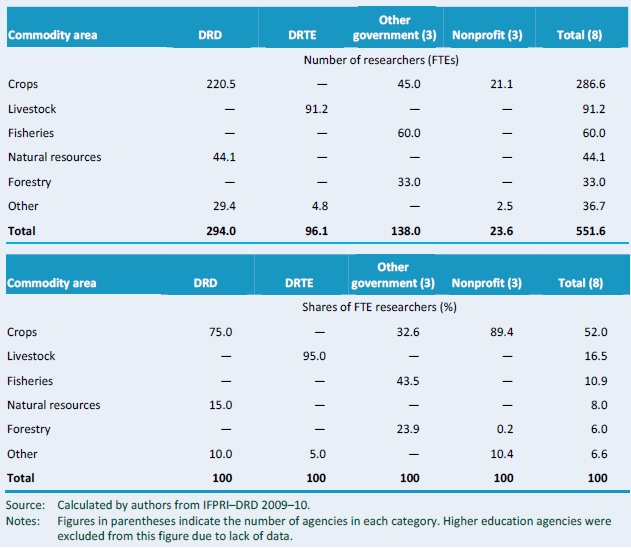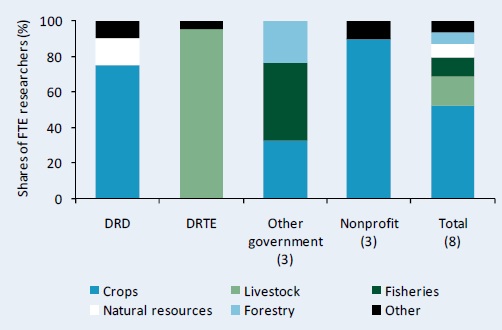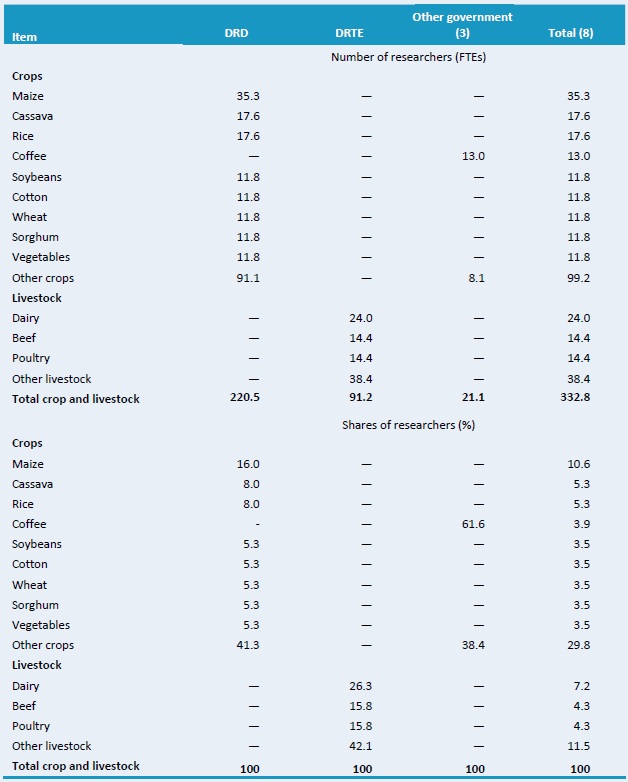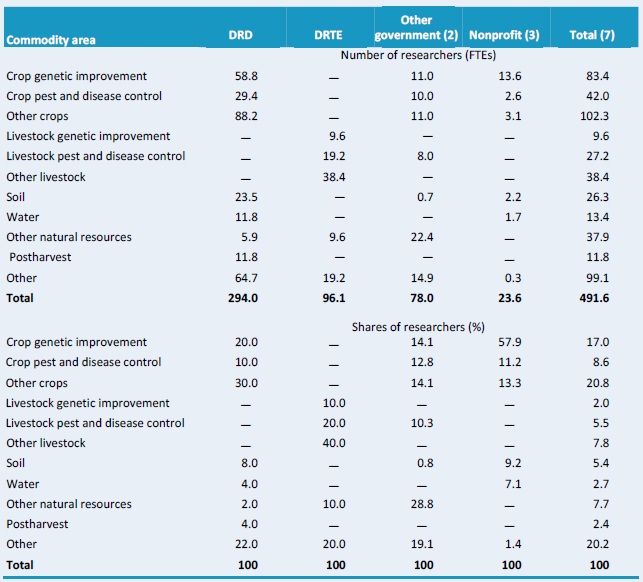The ASTI Data in Focus series provides additional background data in support of the 2010 Country Note on Tanzania (asti.cgiar.org/pdf/Tanzania-Note.pdf) prepared by the Agricultural Science and Technology Indicators (ASTI) initiative and the Department of Research and Development (DRD). Based on data collected by ASTI and DRD, these two outputs review major investment and capacity trends in Tanzanian public agricultural research and development (R&D) since 1991, providing important updates on agricultural R&D trends prepared by ASTI and DRD in 2000 - 03.
D. Research Allocation across Commodities and Themes
This section provides detailed quantitative information on Tanzania public agricultural research allocation in 2008. Supplementary sections present detailed data on long-term trends (Section A), financial resources (Section B), and human resources (Section C). Further supporting information provides macroeconomic trends, a list of agencies included in the study, data sources and estimation procedures, and ASTI's methodology.
Table D1–Research focus by major commodity area, 2008
This table presents the number of researchers by major commodity area in both absolute and relative terms. The focus of agricultural research in Tanzania, excluding the higher education sector for which data were not available, is predominantly crops. In 2008, 287 of Tanzania's 674 full-time equivalent (FTE) researchers focused on crop research. Of the remaining researchers, 91 FTEs focused on livestock, 60 FTEs focused on fisheries, 44 FTEs focused on natural resources, 33 FTEs focused on forestry, and 37 FTEs focused on other commodity areas.

Source: Calculated by authors from IFPRI - DRD 2009 - 10.
Notes: Figures in parentheses indicate the number of agencies in each category. Higher education agencies were excluded from this figure due to lack of data.
Figure D1–Research focus by major commodity area, 2008
This figure presents the allocation of FTE researchers across different commodity areas (see also Table D1). In 2008, 52 percent of researchers were involved in crop research, whereas 17 percent focused on livestock, 11 percent focused on fisheries, 8 percent focused on natural resources, and 6 percent focused on forestry. The remaining researchers concentrated on socioeconomic research, pastures and forages, or other areas.

Source: Calculated by authors from IFPRI - DRD 2009 - 10.
Notes: Figures in parentheses indicate the number of agencies in each category. Higher education agencies were excluded from this figure due to lack of data.
Table D2–Focus of crop and livestock research by major item, 2008
Maize was the most heavily researched commodity at DRD in 2008, constituting 16 percent of all crop and livestock research undertaken by the agency in terms of FTEs. Cassava and rice were also prominent, with shares of 8 percent each. Other significant crops at DRD were soybeans, cotton, sorghum, vegetables, and wheat (recording shares of 5 percent each). At the commodity-based nonprofit institutes, coffee dominated research efforts because TACRI is the largest of these three agencies. Within livestock research, dairy attracted the attention of most livestock research, constituting 25 percent of researchers employed at DRTE, followed by beef and poultry with shares of 16 percent each.

Source: Calculated by authors from IFPRI - DRD 2009 - 10.
Notes: Figures in parentheses indicate the number of agencies in each category. TAFORI and TAFIRI conduct neither crop nor livestock research. TPRI conducts crop research, but disaggregated commodity data were not available. Higher education agencies were excluded due to lack of data.
Table D3–Focus of crop and livestock research by major theme, 2008
This table shows FTE researchers by thematic area in absolute and relative terms. In 2008, crop genetic improvement accounted for 17 percent of total FTE researcher time, whereas 9 percent of researchers focused on crop pest and disease control. Two percent of researchers focused on livestock genetic improvement, while 6 percent focused on livestock pest and disease control. Natural resources were also a major theme. The focus of the remaining researchers included farming systems, food safety, socioeconomics, capacity training, and postharvest issues.

Source: Calculated by authors from IFPRI - DRD 2009 - 10.
Notes: Figures in parentheses indicate the number of agencies in each category. This table excludes one government agency and five higher education agencies for which data on thematic focus were not available.
Copyright (C) 2011 International Food Policy Research Institute and Department of Research and Development. Sections of this Data in Focus issue may be reproduced without the express permission of, but with acknowledgement to, IFPRI and DRD. This series has been prepared as an output for the ASTI initiative and has not been peer reviewed. Any opinions stated herein are those of ASTI and do not necessarily reflect the policies and opinions of IFPRI or DRD.
